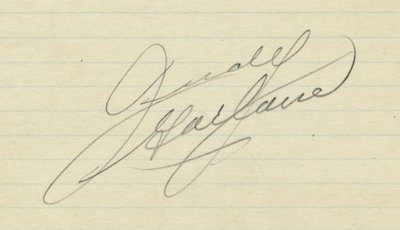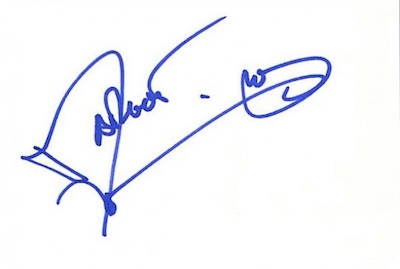The Inner Critic in Handwriting
Episode #7 of the course How to analyze signatures by Annette Poizner
“In the inner courtroom of my mind, mine is the only judgment that counts.” —Nathaniel Branden, PhD, Canadian-American psychotherapist and author
Handwriting can reveal the degree to which writers suffer from an active inner critic. When we look at signatures, we notice when the writer crosses a T-bar or forms a lower loop with such gusto that they actually end up crossing out their name.
If you think about it, signing your name and then X-ing it out is an act of self-negation. Imagine if every time you sign your name—an assertion: “This is me”—that you are, at the same moment, negating that very name/self.
Here are some signatures of prominent public figures who effectively crossed out their names/parts of their names when they signed.

Signature of actress Judy Garland

Signature of author Ernest Hemingway

Signature of actress Margaux Hemingway (granddaughter of Ernest)

Signature of actress Marilyn Monroe
Robert Heinlein said, “Suicide is the most sincere form of self-criticism.” All the writers above effectively took their own lives. Margaux Hemingway killed herself on the anniversary of Ernest Hemingway’s suicide.

Signature of late singer Michael Jackson
According to Michael Jackson’s ex-wife, Jackson suffered from debilitating self-criticism about his looks, to the degree that he wore makeup when he went to sleep at night.
Note that not all writers who sign this way kill themselves. You know many people who innocently sign with an underscore or long t-crossing and in so doing, strike out some of the letters in their name. These are generally people who have difficulty being compassionate toward themselves. Having said that, if the writer has fine-motor problems, a visual disability, or wrote the signature quickly or while in a moving vehicle, that interpretation won’t stand.

Signature of musician Quincy Jones
How to Change?
People often ask: “Can you change your personality by changing your handwriting?” Generally, I say there are faster means to make personal changes, with one exception. If you are a person who inadvertently scratches out your own name when you sign on the dotted line, stop doing that. Every time you strike yourself out graphically, you repetitively reinforce a quietly self-critical impulse. Those tendencies can pull you down, trigger self-sabotage, and hurt your confidence.
If someone in your world consistently crosses out their own name each time they sign a document, bear in mind that your client, friend, or colleague experiences self-blame. Having an active inner critic may mean they tolerate little criticism from you and can find slights where none were intended. Tread cautiously; try and be supportive, and keep their sensitivities in mind. You are dealing with someone who experiences more than average internal stress.
Perhaps with today’s lesson, you can see that we get insights that relate to personal function when we analyze handwriting. In fact, therapists, coaches, or counselors learn a lot about their clients by using this European technique that is readily available to those who wish to study it.
Tomorrow, let’s look at what we can learn about the personality of another character we meet in contemporary life: the performer.
Recommended reading
Graphology in Clinical Practice
Share with friends

